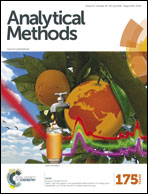Development of a novel method for the bioanalysis of benfotiamine and sulbutiamine in cancer cells
Abstract
Quantification of benfotiamine and sulbutiamine, synthetic thiamine analogs, in biological samples is an essential step toward understanding the role of these thiamine analogs on cancer cell proliferation. A sensitive method to quantitate benfotiamine and sulbutiamine in cells and media was successfully developed using reversed-phase HPLC. Accuracy, precision, specificity and robustness were evaluated to assess the reliability of this method in accordance with U.S. FDA guidelines. The method provided a linear range from 100–50 000 nM for benfotiamine and from 500–30 000 nM for sulbutiamine in both cells and media. The method was validated and the precision was found to be within 15% relative standard deviation (RSD), and the accuracy to be within 15% relative error (RE). Benfotiamine and sulbutiamine were used as internal standards for each other to achieve a high level of reproducibility. This method has been successfully applied to the study of benfotiamine and sulbutiamine to determine their uptake and disposition between mammalian cells and cell media. The method can contribute to future studies to determine the effect of benfotiamine and sulbutiamine as novel thiamine analogs on cancer cell proliferation.

- This article is part of the themed collection: In memory of Craig Lunte

 Please wait while we load your content...
Please wait while we load your content...